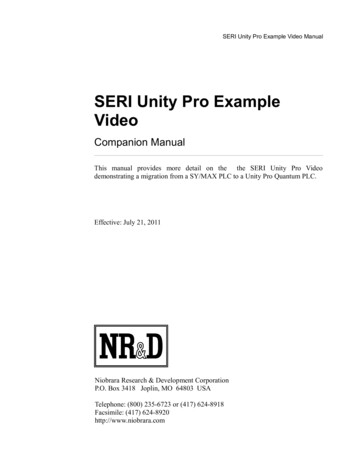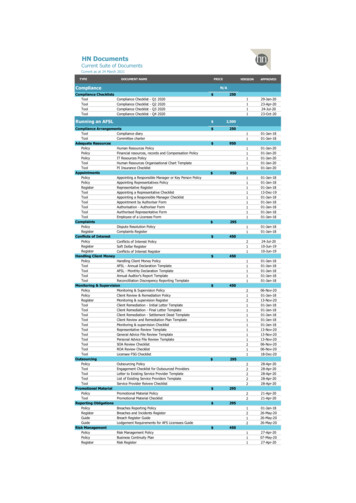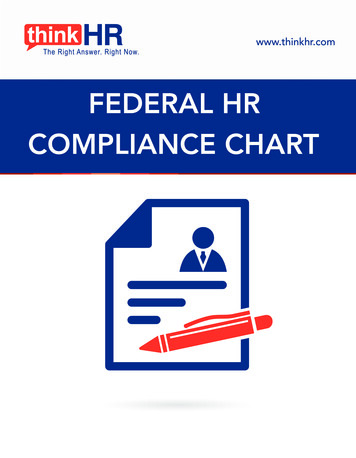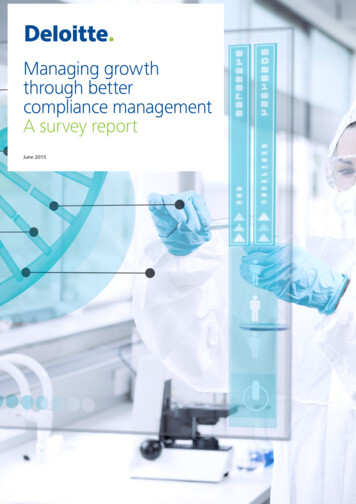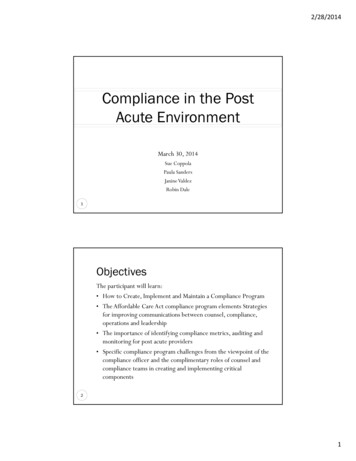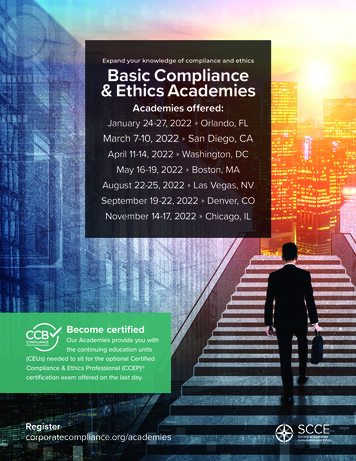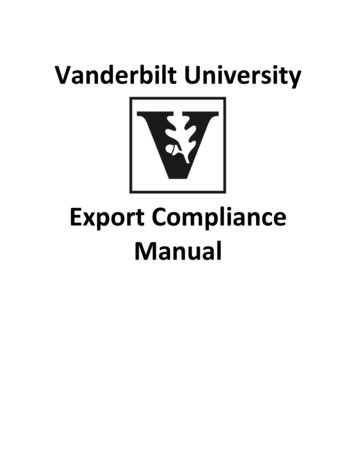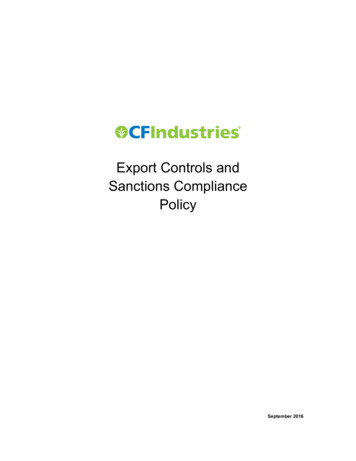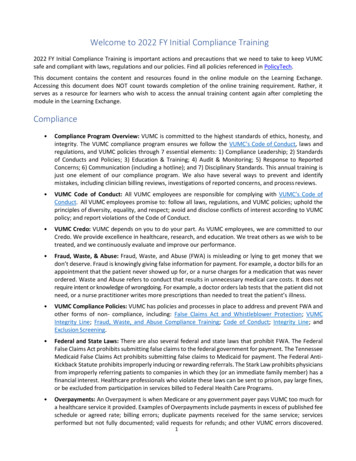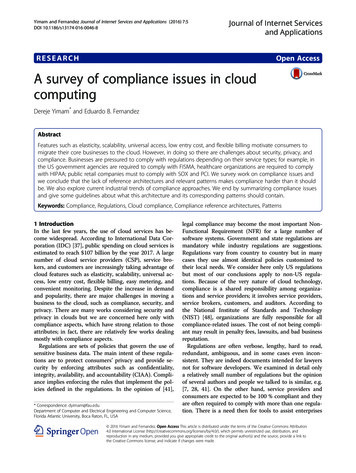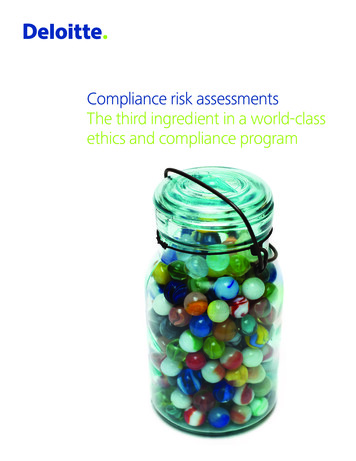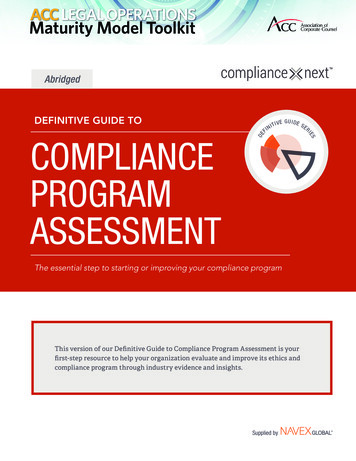
Transcription
AbridgedE GUIDESERVE GU I DE SERIEThis version of our Definitive Guide to Compliance Program Assessment is yourfirst-step resource to help your organization evaluate and improve its ethics andcompliance program through industry evidence and insights.Supplied byITIVE GU I DE SERSThe essential step to starting or improving your compliance ESSMENTNFIDEDEFINITIVE GUIDE TO
Why Is Compliance ProgramAssessment Important?A strong ethics and compliance program improves1organizational culture, protects corporate reputation andenhances employee engagement. When an ethics andcompliance program is lacking, an organization couldbe exposed to significant risk. To ensure complianceprograms meet ongoing best practices, assessments and2regular reviews are necessary, valuable and expectedby numerous internal and external parties, includinggovernment agencies.Your ethics and compliance program is an ecosystemof moving parts. New laws and regulations, new lines of3business, new geographies and mergers and acquisitionsbecome part of a growing enterprise your complianceecosystem must support. This requires those in chargeof the system to regularly revisit and assess their risk andpriorities to make necessary adjustments that ensure aneffective compliance program.Simply put:An ethics and compliance program assessment is a comprehensive evaluation of how your program:»» Measures up against organizations with similar size, industry and footprint»» Meets globally recognized industry accepted standards»» Helps close gaps in risk mitigation and defines improvements in a prioritized manner via a multiyear workplan to achieve your organization’s desired level of program maturityBasic DefinitionsAs you work through your program assessment, use these basic definitions to effectively communicate the programcharacteristics you are working on as well as ensure all those who review the assessment share a common language.Program EffectivenessProgram EfficiencyDid we take the right actions?Did we execute them well?Program ImprovementDemonstrated ValueHas organizational learning been put intoDo we have proof points by stakeholder?action?1ABRIDGED DEFINITIVE GUIDE: COMPLIANCE PROGRAM ASSESSMENT
Key Goals of Compliance Program AssessmentMeasure impact onEnsure key, fundamentalprogram elements arein place (e.g., a hotlineand incidentorganizational culture,Evaluate the effectivenessincluding employeeof program implementationawareness of, andengagement with,management system)the programThe Importance of CultureAlong with assessing for external factors, a robust program must account for an important internal variable – humanbehavior. Even with strong policies and compliance procedures in place, employee behavior presents the highest riskfor your compliance program. It is difficult to know if your efforts are truly changing behavior, fostering ethical practicesand reducing risk without assessing effectiveness at the individual employee level. A robust quality assessment will helpyou understand the impact your current ethics and compliance program is having on employees as well as the overallcorporate culture.Does your organization have an effective compliance program assessment? This handychecklist will help you see how you rate.Has your organization developed a well-defined risk profile?Does your organization have an Employee Ethics Committee?Has your organization identified unique organizational gaps with specific guidance needs to be provided to employees?Does your organization have a communications plan for policy awareness and training?Does your organization use a tracking system for all reports and issues received?View the Full Definitive Guide to Compliance Program Assessment2ABRIDGED DEFINITIVE GUIDE: COMPLIANCE PROGRAM ASSESSMENT
ASSESSMENTPrepare for an Assessment thatProduces Actionable ResultsThere are many things to consider in preparationfor an ethics and compliance program assessment.The first, however, should be determining who willauthorize it. A program assessment that is requestedand authorized by your board of directors carriesthe most weight both internally and externally.Program assessments that are authorized by seniormanagement or the general counsel’s office, andprovide board-level visibility and support, are alsoeffective.Along with authorizing, consider who will manage theassessment. It is likely this responsibility will fall to the senior compliance executive. But in some cases, the assignmentmay be given to another department like Audit or Legal.Attorney-Client Privilege?Regardless of who is authorizing or conducting the assessment, there is an additional consideration: whether or notit should be conducted under attorney-client privilege. A benefit of doing an assessment under the direction of anattorney is knowing that any performance or documentation gaps uncovered can be examined and addressed with lessfear that the results will be discoverable in legal proceedings. On the negative side, working under and maintainingprivilege means that communication of the assessment findings and recommendations must be rigorously controlled,usually limited to those with a “need to know.”How Do You Define Effectiveness?This is the age-old question with an answer that will vary by audience. What is important to employees may differ fromwhat is important to regulators or your board. Before you begin your assessment, take the necessary steps to define adefinition of effectiveness that supports your program and its goals.As you set the goals of your program assessment, consider how effectiveness will be determined in regard to thefollowing categories: awareness, behavior change, risk control, resources, regulatory compliance and program progress.3ABRIDGED DEFINITIVE GUIDE: COMPLIANCE PROGRAM ASSESSMENT
How Do External Parties Define Effectiveness?There is no single standard that suits all situations or organizations; however, various guidelines and frameworks arealigning on a similar set of standards with varying levels of emphasis on program components such as anti-bribery andcorruption. The timeline below shows examples of governmental and international 420102011201220132015SarbanesDodd-FCPADOJOxley n assessing your program, it may be most useful to start with these three guiding measures for a well-roundedprogram: U.S. Federal Sentencing Guidelines 8B2.1; COSO Framework’s 17 Principles of Effective Internal Control; andthe recently released U.S. Department of Justice Evaluation of Corporate Compliance Programs.U.S. Federal Sentencing Guidelines for OrganizationsThe guidelines state, in part, that to have an effective compliance and ethics program, an organization shall: “Exercise duediligence to prevent and deter criminal conduct; and otherwise promote an organizational culture that encourages ethicalconduct and a commitment to compliance with the law.”COSO Framework’s 17 Principles of Effective Internal ControlThe COSO Framework highlights 17 principles within five internal control components designed to “improve organizationalperformance and oversight and to reduce the extent of fraud in organizations.”U.S. Department of Justice Evaluation of Corporate Compliance ProgramsThe DOJ evaluation provides “common questions that we may ask in making individualized determination” to effectivelyaccommodate a company’s unique risk profile and the solutions it uses to reduce its risks.4ABRIDGED DEFINITIVE GUIDE: COMPLIANCE PROGRAM ASSESSMENT
Who Determines Effectiveness?How you define effective should take into account for whom you are defining it. An effective compliance program canmean different things to different stakeholders. For your program to truly be considered effective, it must hold up to anumber of varying perspectives. Consider the perspectives below as you define effective for your program:»» Federal Sentencing Guidelines»» Board of directors»» Ethics officer»» Customers/Suppliers»» Employees»» Shareholders»» Senior management»» U.S. AttorneysWhat Proves Effectiveness?Effectiveness is captured through data-driven information. This information is the evidence you can cite to prove yourprogram’s effectiveness objectively. Use the materials listed below as your guide to identifying the information you willassess to prove your program’s effectiveness in the eight essential components of a compliance program.Materials to Collect from Your Management SystemsPolicy ManagementEcosystem Management»» Code and policy attestations»» Benchmarking with peers»» Incidents of non-compliance»» Employee surveys»» Code of Business Conduct»» Employee focus group data»» Mission and values statement»» Exit interview feedback»» Incentive documentation»» Performance evaluation/»» Standards and proceduresIncident Management»» Retaliation reportsand findings»» Helpline call tracking,trending and benchmarkingHR statistics»» Investigations dataappraisal instruments(from HR)»» Internal auditsThird-Party Risk Management»» Organizational structureTraining Program Management»» Risk assessments»» Quality metrics»» Executive communications»» Third-party audits»» Responses to issues found»» Legal actions»» Training evaluations5ABRIDGED DEFINITIVE GUIDE: COMPLIANCE PROGRAM ASSESSMENT
IMPLEMENT & MEASUREAssess the Eight EssentialComponents of an Effective Program1.Risk AssessmentA risk assessment is key to developing yourorganization’s risk profile. Your risk profile is anevaluation that identifies the unique risks yourorganization may face given its industry,geography and employee population.2.Oversight, Structure & LeadershipYour program needs both appropriate oversight to protectfrom risk and commitment from leadership to drive behaviorand culture. Therefore it is essential to inform and engageyour senior management and board of directors in yourprogram and its goals.3.Standards, Policies, & ProceduresYour policy assessment identifies that your organization has a code of conduct as well as standards and proceduresin place that ensure compliance with internal values as well as applicable governmental laws, rules and regulations.4.Alignment with HR PracticesThe efforts of your HR department and your compliance program should be complementary. Proper assessment ofyour program will ensure HR and compliance policies never conflict in what is expected or required of employees.5.Communications & TrainingA strategic communications plan and training program keeps employees informed and tested on the policies theyare responsible for knowing. A regular and effective communications plan will ensure employees are aware ofpolicies, mangers know their responsibility to respond to raised issues and lessons learned are consistently usedto improve culture.6.Reporting & ResponseYour compliance assessment will evaluate your reporting process to ensure employees can easily and comfortablyreport issues. It will also assess your program’s process to respond to and resolve those reports.7.Monitoring & AssessmentEvaluate the effectiveness of your assessment process itself. This is an opportunity to work with your internal auditteam as well as other subject matter experts who can provide insight to the mitigation of risk, or lack thereof, fromprogram efforts.8.CultureThere is always some variance between what your organization has communicated and what employees believeto be true. Your program assessment will evaluate the methods in place to drive culture and the effectiveness ofthose efforts to change behavior.6ABRIDGED DEFINITIVE GUIDE: COMPLIANCE PROGRAM ASSESSMENT
Systematize Your AssessmentWhen evaluating each program component, we recommend using a simple three-tiered system for grading each area:green, yellow and red.»» Green indicates best practices are being met with robust processes in place»» Yellow indicates the component is in process or partially meeting best practices»» Red indicates not yet meeting best practices or needs attentionSample Assessment ChecklistProgram ComponentOversight, Structure & LeadershipIs the board of directors knowledgeable about the content and operation of the ethics program?Does the board exercise reasonable oversight of the implementation and effectiveness of the programand the organization’s culture?Does the organization have a high-level person and a person with day-to-day responsibility assignedto manage the program? Is there a defined relationship with the board of directors?Is the board (or a committee thereof) accessible to individuals with day-to-day responsibility includingmeeting with them in executive sessions?Does the board (or a committee thereof) receive timely reports of significant issues and investigationsinvolving the company or any elected officers?Does senior leadership understand and exercise their responsibilities to create and maintain a culturethat supports compliance with the law and ethical conduct?Is there an Ethics Committee or Council of company management that receives information from thehigh-level person or the person with day-to-day responsibility and also provides practical input intothe program?If appropriate, are there committees or councils designated to ensure that ethics initiatives areappropriately deployed in regional areas where significant differences in requirements or culture couldleave certain risk areas unaddressed?Have ethics responsibilities been assigned to line management? Are they knowledgeable about thecontent and operation of the ethics program?View the Full Definitive Guide to Download a Comprehensive Assessment Checklist7ABRIDGED DEFINITIVE GUIDE: COMPLIANCE PROGRAM ASSESSMENT
REPORT & IMPROVEPackage & Share Your Assessmentin a Way that Is MeaningfulReportAfter you have completed your program assessmentand benchmarking, it is time to report your findings.Although the raw data may be very helpful to youand your team, the larger audience of your results willbenefit from an intuitive packaging of your findings.To do this, the results from your assessment shouldtell a story that demonstrates the effectiveness of yourprogram and how it applies to the mission and values ofyour organization as well as its strategic operating plans.A Story of EffectivenessUse the data you collected from your assessmentand the insights you derived from benchmarking toanchor your story in evidence, while adding in the moreabstract observations and attitudes as the culturalmanifestations of that data.Presenting Your Effectiveness StoryWhen presenting your findings to your larger audience, which should include your board, CEO and senior management,take the time to make it compelling.Your presentation should:»» Follow an executive summary. Key findings of your assessment should be highlighted clearly before diving deeperinto more granule details.»» Be consistent. The look, feel, format and data used for reports should be consistent so your audience can easilymake connections between your data points.»» Be strategic. The report should support orexplain gaps in the compliance program’s and company’s strategy.»» Provide context. Avoid supplying data without context supporting its inclusion. Seize the opportunity to explainhow KPIs are being reflected in the data.»» Drive toward outcomes. It is helpful to your board, CEO and senior management to understand how yourcompliance program assessment ties into program goals and outcomes.8ABRIDGED DEFINITIVE GUIDE: COMPLIANCE PROGRAM ASSESSMENT
CONCLUSIONAssessment is part of your compliance program’s necessary life cycle for improvement. We work in an everevolving landscape of risk that requires compliance professionals to identify the gaps their programs havetoday, and may have tomorrow. Your program effectiveness as a whole is based on the effectiveness ofeach one of its parts. So, ensure your assessment is broad as well as in-depth. Program assessment is not acheck-the-box exercise. It is just as important as creating a company culture and mitigating risk.Remember, if your assessment is thorough and effective, you will have identified weaknesses in yourprogram and vulnerabilities for risk. Don’t be discouraged by your work to highlight these areas forimprovement. Your program and your organization will be better for it once you make the necessaryadjustments for a robust and effective ethics and compliance program.Download the Full Definitive Guide to Compliance Program AssessmentABOUT NAVEX GLOBALNAVEX Global’s comprehensive suite of ethics and compliance software, content and services helps organizations protect theirpeople, reputation and bottom line. Trusted by 95 of the FORTUNE 100 and more than 12,500 clients, our solutions are informedby the largest ethics and compliance community in the world. 1 866 297 0224info@navexglobal.com 2017 NAVEX GLOBAL. ALL RIGHTS RESERVED.www.navexglobal.com12.05.18
compliance program is lacking, an organization could be exposed to significant risk. To ensure compliance programs meet ongoing best practices, assessments and regular reviews are necessary, valuable and expected by numerous internal and external parties, including government agencies. Your ethics and compliance program is an ecosystem
